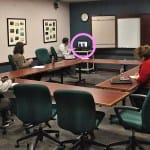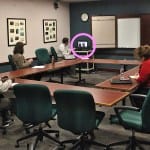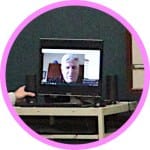Public’s work continues in Bloomington under COVID-19 protocols



At a time when the COVID-19 pandemic has caused cancellation of several public meetings, Bloomington’s city council now has an additional, special meeting on its calendar set for March 25th.
The extra meeting was added so that the council can act to approve the re-funding of some waterworks bonds. The utilities services board approved the bond re-funding this past week. And the council’s action will set up the city to save about $2.3 million in interest.
Even if that kind of public business continues to get done, it’s not business as usual.
The city council chambers have been configured to reflect the most common precaution against spreading the COVID-19 virus: social distancing. About 60 audience chairs have been stacked to the sides of the chambers, leaving four rows in the center with at least a chair-wide gap between each seat.

A briefing on the waterworks bond re-funding, given by director of utilities Vic Kelson, took place at the city council’s work session on Friday.
Kelson didn’t attend the meeting in person. Instead, in the interest of social distancing, he appeared on a computer screen set up in the McCloskey Conference Room at city hall, where the meeting had been re-located.
Deputy council attorney/administrator Stephen Lucas tested out Skype and Zoom, before settling on Google Meet. Four council members also joined Friday’s work session using the Google Meet platform. Councilmember Isabel Piedmont-Smith was the only one who participated actively—the others left their mics mostly muted.
The audio from Piedmont-Smith was not pristine—it was a little patchy in spots—but still made for serviceable communication.
Just two councilmembers were physically present for the work session—Jim Sims and Sue Sgambelluri. For the purposes of a work session, where information is received but no decisions are made, quorum is not at issue.
But under Indiana’s Open Door Law (ODL) the four councilmembers who attended via Google Meet would not have counted towards the minimum five out of nine that are needed to reach a quorum. The ODL also does not allow for a councilmember to use a video-teleconferencing platform to cast a vote.
The ODL does not address whether the public can participate in a public meeting using a digital platform without being physically present. That’s because there’s no requirement under the ODL that any public comment be allowed at a public meeting. The ODL just requires that the public have access to the meeting so that its proceedings can be recorded.
The elimination of physically-present public comment was something Kelson had briefed the utilities services board (USB) about on Thursday, when the USB met to give its approval of the waterworks bond re-funding.
The elimination of public comment is part of the USB’s plan to pare down its meetings to the bare essentials—just the action items that get the bills paid and the contracts signed. Staff reports will also be eliminated from USB meetings. The idea is to shorten the meetings and thereby limit COVID-19 transmission risk.
At Friday’s work session, Councilmember Jim Sims suggested a similar approach to city council meetings—prepare in advance using remote connections and then meet in person just to vote. “We could do it in about 15 minutes and then get out of there,” Sims said.
Based on the city council’s Friday work session, there’s not currently a plan to curtail public comment from people who are physically present at a meeting.
Piedmont-Smith asked if any arrangements could be made to allow for those who are not in council chambers to comment using some kind of digital platform. She was responding to an recently emailed request from Randy Paul, a long-time disabilities advocate.
Paul asked the council to consider allow public comment by phone or other means for people like him, who are in COVID-19 high risk categories—over 60 years old and with compromised immune systems.
Lucas told Piedmont-Smith that the idea has been floated, but not a lot of progress had been made on the logistics. Lucas said it had been a challenge just to set up the remote access for that day’s work session. He wasn’t sure if the Google Meet platform would work for public comment. For that day’s session he needed to send a link to all the people who were participating on that platform.
One alternative Lucas mentioned was to invite people to send in their comments using the city council’s email address and to monitor that during meetings.
Whatever alternative platform is used for collecting public commentary, Lucas said, it would need to be checked into more thoroughly before advertising that it would be used.




Comments ()